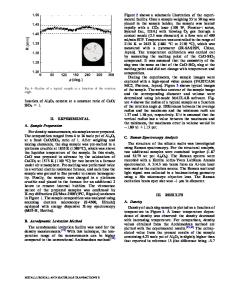Effect of Al 2 O 3 on the Viscosity and Structure of CaO-SiO 2 -MgO-Al 2 O 3 -Fe t O Slags
- PDF / 753,017 Bytes
- 5 Pages / 593.972 x 792 pts Page_size
- 22 Downloads / 384 Views
it is estimated that the steelmaking industries in China generate 80 to 100 million tons of steelmaking slags. These steelmaking slags are partly utilized as soil conditioners and fertilizers, for recovery of metals or recovered in iron- and steelmaking process, etc., and most of them are disposed into the slag pit, causing series of environmental problems and waste of re-
ZHANJUN WANG, Doctoral Candidate, and MEI ZHANG and MIN GUO, Professors, are with the State Key Laboratory of Advanced Metallurgy, School of Metallurgical and Ecological Engineering, University of Science and Technology Beijing, Beijing 100083, P.R. China. Contact e-mail: [email protected] YONGQI SUN, Doctoral Candidate, and ZUOTAI ZHANG, Professor, are with the Department of Energy and Resources Engineering and Beijing Key Laboratory for Solid Waste Utilization and Management, College of Engineering, Peking University, Beijing 100871, P.R. China. Contact e-mail: [email protected] SEETHARAMAN SRIDHAR, Professor, is with the WMG, Steels Processing Research Centre, University of Warwick, Coventry CV4 7AL, U.K. Manuscript submitted October 29, 2014. METALLURGICAL AND MATERIALS TRANSACTIONS B
sources.[1] Some of these disposed slags contain valuable elements such as P or V.[2–5] Therefore, it is of great importance to investigate the possibilities of reasonable treatment of the produced steelmaking slags and efficient recovery of these valuable elements. How to successfully achieve the utilization of these valuable elements has drawn much attention during past decades.[2–6] Under this condition, the selective crystallization and phase separation (SCPS) method was put forward and has been extensively investigated.[7,8] The main factor of SCPS method is to enrich the valuable element into a certain phase and to make the enriched phases grow large enough through modifying the steelmaking slags. Among the modifying methods, the addition of alumina or high alumina contained solid waste such as coal ash was generally used, and the enrichment of the valuable element was further achieved.[2,3] During the recycling of P from steelmaking slags, Lin et al.[2] found that when the Al2O3 content was more than 15 wt pct, with increasing of Al2O3 content, the early precipitated low phosphorus solid solution n2CaOÆSiO2-3CaOÆP2O5 (nC2S-C3P) reacts with Al2O3 in slag to form high phosphorus solid solution n¢C2SC3P. Diao et al.[5] reported that with the addition of Al2O3 into the dephosphorization slag, Ca2SiO4 vanished gradually while Ca3P2O8 and Ca2Al2SiO7 coexisted in the slag and the separation results approved the positive effect of Al2O3 on slag modification behaviors. During the recycling of V from steelmaking slags, Li et al.[3] observed that the phase of 2CaOÆSiO2 with enriched vanadium was preferentially precipitated when V-bearing steelmaking slag modified by Al2O3 was cooled slowly. Wu et al.[9] studied the factory steel slag modified by Al2O3 to form Ca3[(P,V,Si)O4]2 solid solution (V-enrichment phase) and found the Al2O3 would not change the composition
Data Loading...











